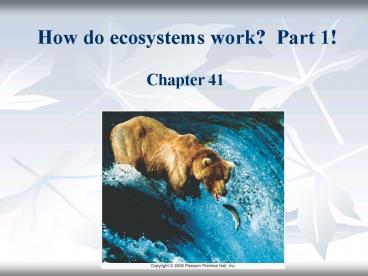How do ecosystems work Part 1 - PowerPoint PPT Presentation
1 / 15
Title:
How do ecosystems work Part 1
Description:
Energy (red) arrows in direction of energy flow. Note heat loss at each step. ... Detritus feeders and decomposers. Consume dead organic matter ... – PowerPoint PPT presentation
Number of Views:51
Avg rating:3.0/5.0
Title: How do ecosystems work Part 1
1
How do ecosystems work? Part 1!
Chapter 41
2
Overview Pathways of energy and nutrients
- Materials cycle
- Note complete cycles for purple arrows.
- Energy flows one way!
- Energy (red) arrows in direction of energy flow
- Note heat loss at each step.
3
Energy flow through communities
- Energy enters communities through photosynthesis
- Carbon dioxide, water and suns energy used
directly for photosynthesis - Inorganic mineral nutrients needed to build other
molecules (proteins, lipids, carbohydrates)
4
Energy flow through communities
- Trophic levels
- Autotrophs
- Which Domains/Kingdoms include at least some
autotrophs? - Heterotrophs or consumers
- Primary consumers herbivores consume primary
producers - Secondary consumers and higher carnivores
consume other consumers - Detritus feeders and decomposers
- Consume dead organic matter
- Convert organic molecules back to inorganic ones
so primary producers can use them (bacteria
mostly do this step.) - What if there were no decomposers?
5
Energy flow through communities
- Terrestrial food chain and trophic levels
- What is missing here?
6
Energy flow through communities
- Marine food chain and trophic levels
- What is missing here?
7
Energy flow through communities
- Trophic levels (cont.)
- Many consumers cannot be strictly categorized
- Omnivores Feed as both herbivores and carnivores
- Many carnivores feed at multiple levels
- Example Leopard seal in Antarctic marine food
web
8
Antarctic marine food web (simplified)
9
Energy flow through communities
- Energy transfer is inefficient
- On average, only 10 of energy gets transferred
from one trophic level to the next (red arrows) - Most of the rest is lost as heat (yellow arrows)
- Some converted to unusable form (i.e.
indigestible for the consumer, such as cellulose
for us.)
10
Energy pyramid shows inefficiency of energy
transfer
11
Biomagnification Unlike energy, toxins become
concentrated up the food web
- Top predators are most affected by toxins
- At the peak of DDT use, predatory birds contained
DDT concentrations up to 1 million times the
concentration in water.
12
Cycling of nutrients Carbon
- CO2 sinks
- Primary producers (via photosynthesis)
- Terrestrial
- Marine (gt50)
- Ocean water
- Ocean sediments
- Carbonification
- Fossil fuels formed from phytoplankton (oil and
gas) and plants (coal, peat)
13
Cycling of nutrients Carbon
- CO2 sources
- Respiration All organisms
- Decomposition
- Fires
- Natural
- For agriculture
- Burning of fossil fuels
- Use 1 million times as fast as it is formed!
14
In sum, decrease of CO2 sinks and increase of CO2
sources
- Increase in global CO2 correlates with global
warming
15
Highest temperature increases are along the
Antarctic Peninsula































